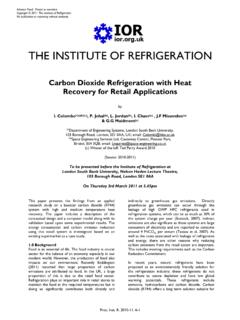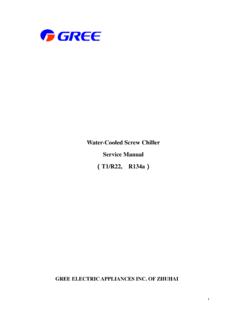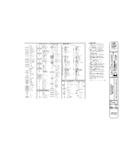Transcription of THE INSTITUTE OF REFRIGERATION - CIBSE ASHRAE
1 INTRODUCTION As the climate changes and the demand for some form of air conditioning or comfort cooling increases, we are forced with the dilemma of trying to maintain a building within a comfortable range of conditions, whilst endeavouring to minimise any impact on the environment. It is more than likely that in commercial buildings some form of mechanical cooling or REFRIGERATION is required. Where this is necessary the Building Services Engineer should look towards the REFRIGERATION Engineer for assistance and guidance in selecting the most appropriate REFRIGERATION system for a particular application.
2 This paper gives an overview of air conditioning, the approach to its design, discusses the problems of REFRIGERATION and suggests how a better understanding will improve both air conditioning design and their respective REFRIGERATION systems. Air Conditioning Air conditioning implies the total automatic control of the internal environment primarily for the comfort of humans. The term is also misused in that it is often adopted to describe a simple ventilation system or comfort cooling just the control of temperature. As summertime temperatures increase and it Advance Proof.
3 Private to members Copyright 2005 The INSTITUTE of REFRIGERATION No publication or reprinting without authority THE INSTITUTE OF REFRIGERATION Air Conditioning A REFRIGERATION Problem by Keith Dunsdon, (Hons)., , , , , Consultant Emeritus (Session 2005-2006) In Association with the CIBSE / ASHRAE Group To be presented before the INSTITUTE of REFRIGERATION at the INSTITUTE of Marine Engineering, Science and Technology, 80 Coleman Street, London EC1 on Thursday 8th December 2005 at Proc. Inst. R. 2005-06. 3-1 would appear that businesses are using more and more power to be effective, we find that to control the internal environment requires some form of mechanical cooling or REFRIGERATION .
4 For thermal well being the body must lose heat at the same rate as the heat being produced. The body temperature is around 37oC db with the lungs a 37oC (wb). Changes in these conditions will affect thermal comfort. The air conditioning designer has a range of products and systems to choose from and must have a wider understanding of all the issues when selecting the type of REFRIGERATION system suitable for a particular application. For the purpose of this paper we will only consider changing the air temperature and reducing the moisture content by the use of REFRIGERATION . Air Conditioning Design Approach Ideally the air conditioning designer should endeavour to avoid the use of mechanical cooling if at all possible, but should it be necessary then the amount of energy required by the REFRIGERATION system should be minimised.
5 The target for the air conditioning designer is to achieve his optimum internal design condition or as near as possible to it, without using any energy in the cooling process. In reality this is highly unlikely and therefore the energy used in the cooling process needs to be minimised by effective and efficient design of the REFRIGERATION system. As a point of interest the air conditioning designer should in all cases carefully review internal and external design conditions in an effort to minimise the cooling load. Low external winter conditions mean more heating is required and high external summer conditions mean more cooling is required.
6 The following techniques should be applied in minimizing the cooling load. 1. Building Layout The orientation of a building should be such that shading is easy to achieve and use made of winter solar gains. 2. Space Planning Rooms with high heat gains or where overheating would be a problem, should be sited on the north side of the building. 3. Solar Shading External - a simple overhang can be very effective in blanking summer sun. Internal - Blinds can contribute but are less effective than external shading. Solar Glass - Reflective glass is better at rejecting solar gain. 4. Thermal Mass Heavyweight structures tend to absorb heat resulting in lower peak temperatures in summer.
7 Night time ventilation will need consideration but It should be remembered that Heavyweight Structures will not readily release heat once absorbed. 5. Natural Ventilation Ventilation will be required to maintain an indoor air quality. The ability to increase the number of air changes by wind driven ventilation and openable windows can be an effective way of controlling overheating. Although in some cases opening windows can in fact make matters worse by creating excessive draughts, dirt and noise, particularly in urban areas. 6. Reduce Internal Gains Specify energy efficient equipment, lighting etc.
8 , switching off when not required. 7. Latent Cooling Latent cooling loads a change in humidity or moisture content, should be avoided if possible. If it is not possible to eliminate the latent load then the control band for relative humidity/moisture content should be made as wide as possible and the air conditioning control system set up to make use of the whole band. Proc. Inst. R. 2005-06. 3-2 8. Calculation It is essential, particularly in view of the Building Regulations (Part L), that calculations are undertaken with care and are accurate. Figures used in heat gain calculations should not be rounded up nor should a % be added to the final loads.
9 Inaccuracies in calculations can add to power consumption and thereby reduce efficiency. As a brief example we can look at an air cooled condenser. In an air conditioning application a 1 degree increase in condensing temperature can increase the power input to the compressor by around 3%. It is easy to appreciate that if under design conditions we wish to reject heat at 30oC, there is a substantial increase in power if we then simply say the REFRIGERATION plant must be capable of rejecting heat at 35oC. If after all the efforts of avoiding REFRIGERATION have been exhausted and mechanical cooling is required then we must be sure that we install the most effective and efficient system.
10 Energy used in Cooling The Psychrometric chart is the Air Conditioning Engineer s Mollier diagram (See Fig 1). The difference being that in REFRIGERATION the chart plots pressure against enthalpy and in air conditioning the chart plots dry bulb temperature against moisture content for a constant barometric pressure. Proc. Inst. R. 2005-06. 3-3 Fig. 1. Psychrometric Chart Fig. 2. REFRIGERATION P-H Diagram By plotting the condition of the air before and after the evaporator means that the amount of energy required from the REFRIGERATION system can be calculated: Air on condition 30oC dry bulb/22oC wet bulb Air off condition 22oC dry bulb/50% r h Cooling load = Air Mass Flow x Change in enthalpy = Mair x (ha hb) This cooling load consists of two components sensible and latent.










